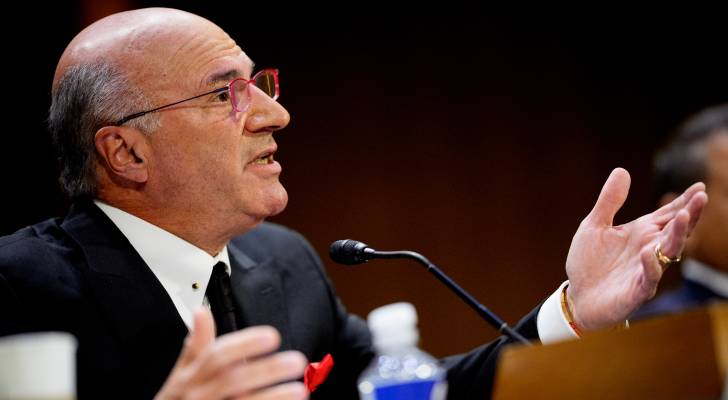
We adhere to strict standards of editorial integrity to help you make decisions with confidence. Some or all links contained within this article are paid links.
For much of last year, President Donald Trump promised “extraordinary” economic benefits from his policies and “the brightest economic future the world has ever seen” for the country. But just months into his second term, the administration is asking Americans to brace for an economic dip instead.
Don’t miss
- I’m 49 years old and have nothing saved for retirement — what should I do? Don’t panic. Here are 5 of the easiest ways you can catch up (and fast)
- Gain potential quarterly income through this $1B private real estate fund — even if you’re not a millionaire. Here’s how to get started with as little as $10
- You’re probably already overpaying for this 1 ‘must-have’ expense — and thanks to Trump’s tariffs, your monthly bill could soar even higher. Here’s how 2 minutes can protect your wallet right now
In a recent interview on CNBC’s Squawk Box, Treasury Secretary Scott Bessent warned that the ongoing efforts to cut back government spending would negatively impact the economy. “The market and the economy have become hooked, become addicted, to excessive government spending and there’s going to be a detox period,” he said.
The impact of the ‘detox period’ may already be unfolding
At the end of 2024, government expenditures as a percentage of gross domestic product was 34%.
However, despite the efforts of Elon Musk to cut costs via the so-called Department of Government Efficiency, there is little evidence that government spending has been reigned in. The federal budget deficit hit $1.3 trillion in March — 15% higher than the same time last fiscal year.
While federal government revenues have risen 3% year-over-year last month, total spending increased by 7%. All told, the government is still spending a huge amount of money.
Meanwhile, tariff-driven uncertainty has caused the stock market to record the most volatile week ever during the second week of April. Plus, JPMorgan & Chase raised the odds of a recession from 40% to 60% earlier this month.
Such drops suggest that the only thing this “detox” is eliminating is economic optimism. Here are three ways you can prepare your portfolio for the ongoing fallout.
Gold
In times of uncertainty and volatility, investors often consider gold to be a safe haven. Amid the recent market turmoil, gold has been regaining steam over the last few months, trading above $3,000 per ounce.
With more uncertainty looming, JPMorgan predicts an ounce of gold could reach an average price of $3,675 by the end of 2025, and $4,000 by the second quarter of 2026.
Adding a little gold exposure to your portfolio could help insulate your wealth.
You can do so by opening a gold IRA with the help of Priority Gold. This way, you can combine the recession-resistant nature of gold and the tax advantages of an IRA.
Opening a gold IRA with Priority Gold is easy — especially if you already have an existing IRA. They offer 100% free rollover, as well as free shipping and free storage for up to five years.
Qualifying purchases can also receive up to $10,000 in free silver.
Priority Gold is an industry leader in precious metals, offering physical delivery of gold and silver. Plus, they have an A+ rating from the Better Business Bureau and a 5-star rating from Trust Link.
To learn more about how Priority Gold can help you grow your retirement nest egg, download their free 2025 gold investor bundle.
Read more: Want an extra $1,300,000 when you retire? Dave Ramsey says this 7-step plan ‘works every single time’ to kill debt, get rich in America — and that ‘anyone’ can do it
Inflation-linked treasuries
While consumer confidence is dropping, expectations of inflation are rising. Consumers surveyed by the University of Michigan said they expect 4.9% inflation in the year ahead, while their long-term inflation expectations have jumped from 3.5% to 3.9%, the highest level in 32 years.
Luckily, the government offers Treasury Inflation Protected Securities, or TIPS, which are designed to protect investors against inflation. For investors worried about the cost-of-living or those living on fixed income, these special treasuries could offer a safe place to park cash.
But note that if you need to access your money in the event of an emergency, you have to sell them in the bond market. While U.S. Treasuries are quite liquid, selling them when the prices are down could lead to losses.
Instead, consider opening a high-yield savings account. These accounts typically offer yields significantly higher than the average yields on traditional savings accounts.
To compare your options and find one that suits your needs, check out Moneywise’s best high-yield savings accounts of 2025 list.
Alternative assets
Despite the 90-day pause on tariffs and increasing calls for trade agreements, the U.S. has yet to reach finalized deals with its major trading partners. As the broader market uncertainty impacts stocks and bonds, investing in alternative assets like real estate and art might help diversify your portfolio.
If you want to invest in real estate but don’t want to take on too much risk, consider tapping into the $36 trillion home equity market.
Homeshares’ U.S. Home Equity Fund is allows accredited investors to gain direct exposure to hundreds of owner-occupied homes in top cities across the country.
Homeshares enters into home equity agreements (HEAs) with the property owners, which typically have built-in downside protection. Because HEAs only represent 25% to 35% of the property’s total value, there’s significant return potential at reduced risk levels.
With risk-adjusted target returns ranging from 14% to 17%, the U.S. Home Equity Fund could unlock lucrative real estate opportunities — without the headaches of buying, owning, or managing property.
This approach provides an effective, hands-off way to invest in high-quality residential properties, plus the added benefit of diversification across various regional markets – with a minimum investment of $25,000.
Another option for diversification is investing in art – which has almost zero correlation with stocks. Bluechip contemporary art has outperformed the S&P 500 index by 43% between 1995 and 2024.
Investing in art was once reserved for the ultra-wealthy, but Masterworks has changed that by enabling retail investors to invest in blue-chip art from the likes of Banksy, Basquiat, and Picasso. From their 23 exits so far, investors realized representative annualized net returns like 17.6%, 17.8%, and 21.5% (among assets held for longer than a year).
It’s easy to get started with Masterworks, and you can even skip the waitlist with this link.
What to read next
- Millions of Americans now sit on a stunning $35 trillion in home equity — here’s 1 new way to invest in responsible US homeowners while targeting a 14%-17% IRR
- Robert Kiyosaki warns of a ‘Greater Depression’ coming to the US — with millions of Americans going poor. But he says these 2 ‘easy-money’ assets will bring in ‘great wealth’. How to get in now
- Here are 5 ‘must have’ items that Americans (almost) always overpay for — and very quickly regret. How many are hurting you?
This article provides information only and should not be construed as advice. It is provided without warranty of any kind.

